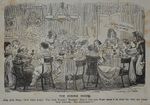Annotation:Punch for the Ladies (1): Difference between revisions
No edit summary |
No edit summary |
||
| (5 intermediate revisions by 2 users not shown) | |||
| Line 1: | Line 1: | ||
== | {{TuneAnnotation | ||
|f_tune_annotation_title= | |||
|f_annotation= | |||
'''PUNCH FOR | [[File:punchladies.jpg|150px|left|thumb|right|The ladies drinking session. Punch Magazine, 1853.]] | ||
'''PUNCH FOR LADIES [1].''' AKA and see "[[Humors of Glenflesk (The)]]," “[[Maguire's March (2)]]," "[[Rolling Wave (1) (The)]]." Irish, Jig. G Major. Standard tuning (fiddle). AABB. "In Mr. Pigot's book this tune is given along with 'Negus for Gentlemen' (p. 144), and the two were obviously linked together. Observe the intentional reverse: for punch is the proper drink for gentlemen, and negus for ladies" (Joyce). The word 'punch' derives from a Hindi word, ''panch'', meaning ‘five’, because of it's five ingredients: spirits, water, lemon-juice, sugar and spices. The word was first recorded in English in 1669. There is no musical relationship with the similarly titled "[[Punch for the Ladies (1)]]." | |||
|f_source_for_notated_version= | |||
|f_printed_sources=Joyce ('''Old Irish Folk Music and Songs'''), 1909; No. 705, p. 353. | |||
|f_recorded_sources= | |||
|f_see_also_listing=Alan Ng's Irishtune.info [https://www.irishtune.info/tune/1756/] | |||
}} | |||
Alan Ng's Irishtune.info [https://www.irishtune.info/tune/1756/] | |||
Latest revision as of 07:42, 14 December 2021

PUNCH FOR LADIES [1]. AKA and see "Humors of Glenflesk (The)," “Maguire's March (2)," "Rolling Wave (1) (The)." Irish, Jig. G Major. Standard tuning (fiddle). AABB. "In Mr. Pigot's book this tune is given along with 'Negus for Gentlemen' (p. 144), and the two were obviously linked together. Observe the intentional reverse: for punch is the proper drink for gentlemen, and negus for ladies" (Joyce). The word 'punch' derives from a Hindi word, panch, meaning ‘five’, because of it's five ingredients: spirits, water, lemon-juice, sugar and spices. The word was first recorded in English in 1669. There is no musical relationship with the similarly titled "Punch for the Ladies (1)."


